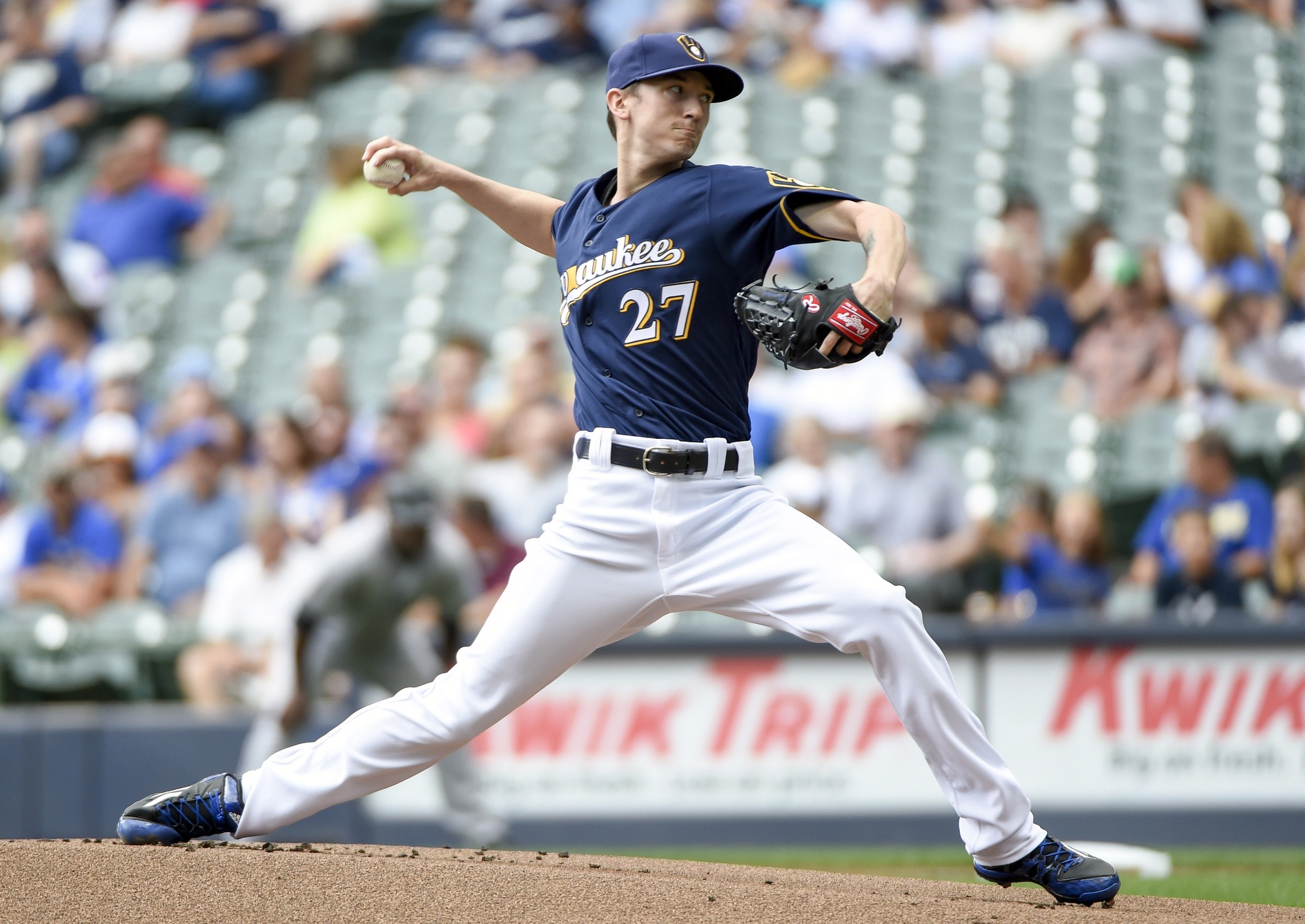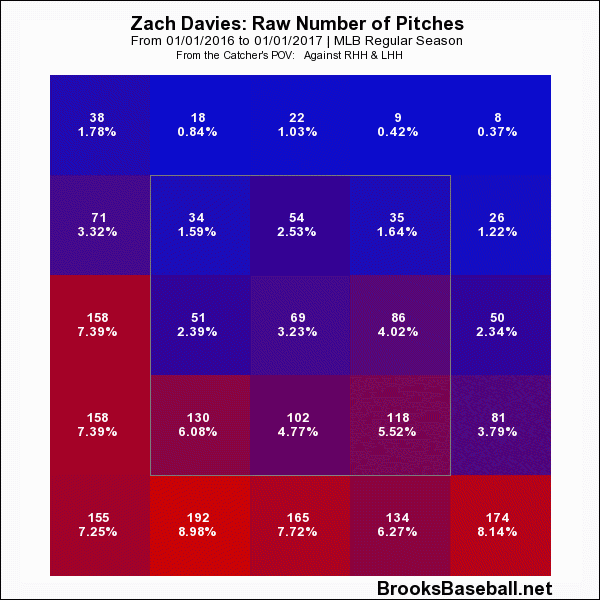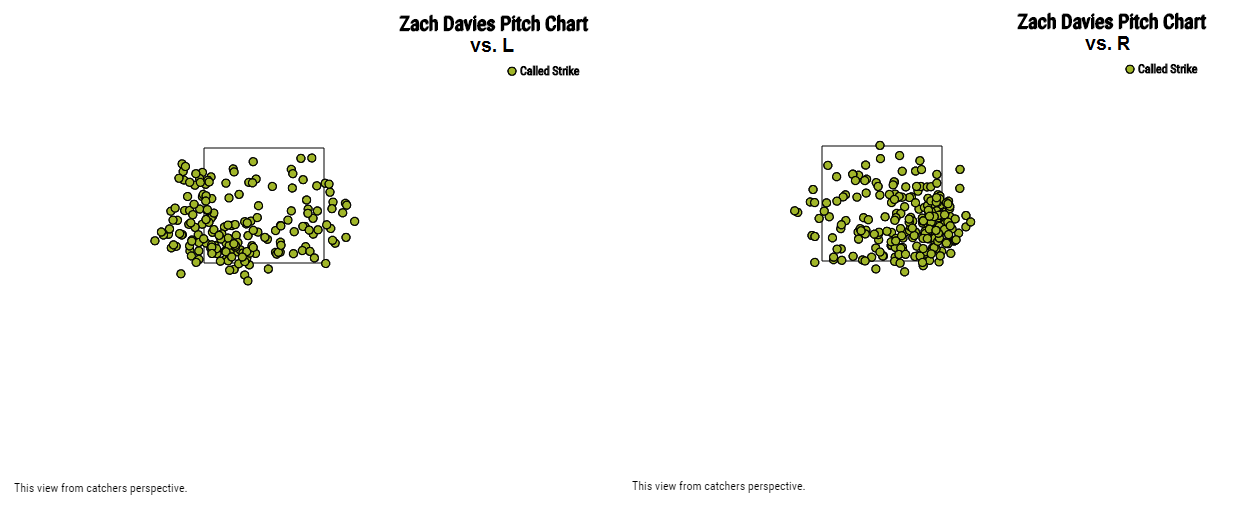While many of the promising current Brewers arrived in Milwaukee during David Stearns’s tenure, one of the best came on in Doug Melvin’s last hurrah. Gerardo Parra sustained a ridiculously fluky, in retrospect if not at the time, hot streak to start the 2015 season. Melvin capitalized on that, flipping him to a thirsty Orioles squad in exchange for a right-handed pitching prospect.
From then until now, all Zach Davies has done is pitch. He earned a cup of coffee when rosters expanded last September, working his way to a 3.71 ERA and 4.14 DRA over six late-season starts. After pitching two games this April in Colorado Springs, he joined the big-league club’s rotation and immediately took off. His 23 starts have seen him notch a 4.06 ERA and 3.96 DRA, each of which makes him (along with Junior Guerra) a dependable starter for a club that doesn’t possess too many of those.
This is solely what we observe on the surface, however. Diving a little deeper into Davies’s profile reveals two facets of his performance — his middling ground ball rate and his deceptively high strike rate — that don’t bode well for the future. Hopefully, for his sake and for the sanity of Brewers fans, he’ll correct these peculiar trends before they sink him.
Throughout his career in the minors, Davies stood apart because of his batted-ball profile. Opposing hitters had a tough time putting the ball in the air: According to BP’s data, he tallied a ground ball rate above 50 percent at every stop, save his 11.0 innings in Triple A this year. Strangely, though, that hasn’t carried over to the major leagues — Davies has kept the ball on the ground just 46.5 percent of the time in 2016, which ranks 60th out of 116 pitchers with at least 100 innings.
The problem doesn’t seem to be location, as Davies has still lived low in the zone:
Batters have simply been able to elevate those pitches, for reasons that defy explanation. It isn’t isolated to one particular offering either — of Davies’s five principal pitches, four lag behind in terms of grounders:
| Pitch | GB% | Rank (Qualifiers) |
|---|---|---|
| Fourseam | 33.3% | 99 (170) |
| Sinker | 52.6% | 59 (106) |
| Change | 34.5% | 63 (67) |
| Curve | 37.8% | 61 (72) |
| Cutter | 53.7% | 3 (43) |
Qualifiers are starting pitchers with at least 200 of the given pitch in 2016.
Davies’s minor-league resume suggests that this isn’t his true talent level. With that kind of zone profile, he’ll likely improve his ground ball rate eventually. If he doesn’t, the fly balls — and the hard contact that he’s allowed on them — will come back to haunt him.
But even sans grounders, Davies has succeeded to this point, as the aforementioned ERA and DRA bear out. That’s primarily thanks to a 6.1 percent walk rate and 19.5 percent strikeout rate. The former falls a great deal lower than the major-league starting pitcher average of 7.7 percent, while the latter lines up fairly closely with the MLB mark of 20.1 percent for starters. In other words, by Ks and BBs, he comes out ahead.
Here, though, the trouble doesn’t go away. Strike rate has a hand in a pitcher’s walk rate, as you’d suspect, in addition to his strikeout rate. And while Davies has thrown a solid amount of strikes this year, at 63.6 percent, that doesn’t match his peripherals:
| Rank | Name | Pitches | Str% | xStr% | Diff |
|---|---|---|---|---|---|
| 1 | Zach Davies | 2138 | 63.6% | 60.2% | 3.4% |
| 2 | Chase Anderson | 2122 | 60.6% | 58.4% | 2.2% |
| 3 | Dallas Keuchel | 2560 | 62.9% | 61.0% | 1.9% |
| 4 | Marco Estrada | 2171 | 63.0% | 61.1% | 1.9% |
| 5 | Jon Niese | 2010 | 64.0% | 62.1% | 1.9% |
| 6 | Jon Lester | 2450 | 64.2% | 62.4% | 1.8% |
| 7 | Madison Bumgarner | 2843 | 66.0% | 64.3% | 1.7% |
| 8 | Michael Wacha | 2181 | 64.4% | 62.8% | 1.6% |
| 9 | Francisco Liriano | 2282 | 59.3% | 57.8% | 1.5% |
| 10 | Mike Leake | 2247 | 66.7% | 65.3% | 1.4% |
By FanGraphs’ PITCHf/x plate discipline data, Davies should have a strike rate 3.4 percentage points lower than he actually does. I wrote about the Brewers’ overperformance in this regard back in May; since then, the trend hasn’t gone away for Davies (or Anderson, for that matter).
The problem for those two Brewers is that this seems like a fluke, because all the other pitchers on that list have received significant help from their catchers. San Francisco, Houston, St. Louis, Toronto, and Chicago employ five of the six best framers in the majors, in Buster Posey, Jason Castro, Yadier Molina, Russell Martin, and Miguel Montero, respectively; Pittsburgh has gotten by with its platoon of Francisco Cervelli and Eric Kratz, each of whom has excelled in a smaller sample. Milwaukee, on the other hand, has seen Jonathan Lucroy continue his framing decline and Martin Maldonado fall off as well. Yet Davies (and Anderson) have nabbed a lot of excess strikes, through seemingly no skill at all.
For whatever it counts, Davies has established a fairly clear trend with his strikes. Against both right- and left-handed hitters, he’ll steal calls on outside pitches that aren’t too low:
With that said, Davies hasn’t been especially adept at painting the corners. His Edge rate of 25.4 percent, per Bill Petti’s data, is one of the lower marks in baseball, so he hasn’t given himself many framable pitches. Pedestrian catchers plus a pedestrian pitcher typically equals pedestrian numbers, but that hasn’t applied to Davies. I’m not too sure that’ll remain the case going forward.
The parade that has been Zach Davies’s 2016 campaign has, thus far, continued without precipitation. Without ground balls or strikes, that might not continue. He’s still just 23, so he has plenty of time to tinker and make progress. At this point, though, he quite clearly has a long way to go, and the road to get there might be bumpier than the route he’s taken to arrive here.
All data as of Thursday, August 25.



1 comment on “The Two Red Flags for Zach Davies”